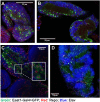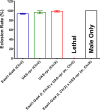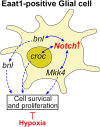Genetic interactions regulate hypoxia tolerance conferred by activating Notch in excitatory amino acid transporter 1-positive glial cells in Drosophila melanogaster
- PMID: 33576765
- PMCID: PMC8022968
- DOI: 10.1093/g3journal/jkab038
Genetic interactions regulate hypoxia tolerance conferred by activating Notch in excitatory amino acid transporter 1-positive glial cells in Drosophila melanogaster
Abstract
Hypoxia is a critical pathological element in many human diseases, including ischemic stroke, myocardial infarction, and solid tumors. Of particular significance and interest of ours are the cellular and molecular mechanisms that underlie susceptibility or tolerance to low O2. Previous studies have demonstrated that Notch signaling pathway regulates hypoxia tolerance in both Drosophila melanogaster and humans. However, the mechanisms mediating Notch-conferred hypoxia tolerance are largely unknown. In this study, we delineate the evolutionarily conserved mechanisms underlying this hypoxia tolerant phenotype. We determined the role of a group of conserved genes that were obtained from a comparative genomic analysis of hypoxia-tolerant D.melanogaster populations and human highlanders living at the high-altitude regions of the world (Tibetans, Ethiopians, and Andeans). We developed a novel dual-UAS/Gal4 system that allows us to activate Notch signaling in the Eaat1-positive glial cells, which remarkably enhances hypoxia tolerance in D.melanogaster, and, simultaneously, knock down a candidate gene in the same set of glial cells. Using this system, we discovered that the interactions between Notch signaling and bnl (fibroblast growth factor), croc (forkhead transcription factor C), or Mkk4 (mitogen-activated protein kinase kinase 4) are important for hypoxia tolerance, at least in part, through regulating neuronal development and survival under hypoxic conditions. Becausethese genetic mechanisms are evolutionarily conserved, this group of genes may serve as novel targets for developing therapeutic strategies and have a strong potential to be translated to humans to treat/prevent hypoxia-related diseases.
Keywords: Drosophila melanogaster; Hypoxia; Notch signaling; eaat1-posive glia; genetic interactions.
© The Author(s) 2021. Published by Oxford University Press on behalf of Genetics Society of America.
Figures






Similar articles
-
What can the common fruit fly teach us about stroke?: lessons learned from the hypoxic tolerant Drosophila melanogaster.Front Cell Neurosci. 2024 Mar 22;18:1347980. doi: 10.3389/fncel.2024.1347980. eCollection 2024. Front Cell Neurosci. 2024. PMID: 38584778 Free PMC article. Review.
-
Experimental selection of hypoxia-tolerant Drosophila melanogaster.Proc Natl Acad Sci U S A. 2011 Feb 8;108(6):2349-54. doi: 10.1073/pnas.1010643108. Epub 2011 Jan 24. Proc Natl Acad Sci U S A. 2011. PMID: 21262834 Free PMC article.
-
Drosophila glial glutamate transporter Eaat1 is regulated by fringe-mediated notch signaling and is essential for larval locomotion.J Neurosci. 2010 Oct 27;30(43):14446-57. doi: 10.1523/JNEUROSCI.1021-10.2010. J Neurosci. 2010. PMID: 20980602 Free PMC article.
-
Mechanisms underlying hypoxia tolerance in Drosophila melanogaster: hairy as a metabolic switch.PLoS Genet. 2008 Oct;4(10):e1000221. doi: 10.1371/journal.pgen.1000221. Epub 2008 Oct 17. PLoS Genet. 2008. PMID: 18927626 Free PMC article.
-
Drosophila, a golden bug, for the dissection of the genetic basis of tolerance and susceptibility to hypoxia.Pediatr Res. 2009 Sep;66(3):239-47. doi: 10.1203/PDR.0b013e3181b27275. Pediatr Res. 2009. PMID: 19542900 Free PMC article. Review.
Cited by
-
Time Domains of Hypoxia Responses and -Omics Insights.Front Physiol. 2022 Aug 8;13:885295. doi: 10.3389/fphys.2022.885295. eCollection 2022. Front Physiol. 2022. PMID: 36035495 Free PMC article. Review.
-
Harnessing full-text publications for deep insights into C. elegans and Drosophila biomaps.BMC Genomics. 2024 Nov 13;25(1):1080. doi: 10.1186/s12864-024-10997-6. BMC Genomics. 2024. PMID: 39538127 Free PMC article.
-
Comparative transcriptomic and metabolomics analysis of modified atmosphere responses in Tribolium castaneum (Coleoptera: Tenebrionidae).J Insect Sci. 2024 Mar 1;24(2):8. doi: 10.1093/jisesa/ieae015. J Insect Sci. 2024. PMID: 38491952 Free PMC article.
-
Notch Signaling in Insect Development: A Simple Pathway with Diverse Functions.Int J Mol Sci. 2023 Sep 13;24(18):14028. doi: 10.3390/ijms241814028. Int J Mol Sci. 2023. PMID: 37762331 Free PMC article. Review.
-
What can the common fruit fly teach us about stroke?: lessons learned from the hypoxic tolerant Drosophila melanogaster.Front Cell Neurosci. 2024 Mar 22;18:1347980. doi: 10.3389/fncel.2024.1347980. eCollection 2024. Front Cell Neurosci. 2024. PMID: 38584778 Free PMC article. Review.
References
-
- Adler D, Pepin JL, Dupuis-Lozeron E, Espa-Cervena K, Merlet-Violet R, et al.2017. Comorbidities and subgroups of patients surviving severe acute hypercapnic respiratory failure in the intensive care unit. Am J Respir Crit Care Med. 196:200–207. - PubMed
-
- Alberi L, Hoey SE, Brai E, Scotti AL, Marathe S.. 2013. Notch signaling in the brain: in good and bad times. Ageing Res Rev. 12:801–814. - PubMed
-
- Andersson ER, Sandberg R, Lendahl U.. 2011. Notch signaling: simplicity in design, versatility in function. Development 138:3593–3612. - PubMed
Publication types
MeSH terms
Substances
Grants and funding
LinkOut - more resources
Full Text Sources
Other Literature Sources
Molecular Biology Databases
Miscellaneous
